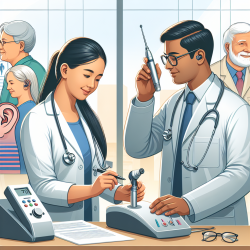Introduction: The Shift to Virtual Clinical Experiences
The COVID-19 pandemic has significantly altered the landscape of healthcare education, prompting a shift towards virtual clinical experiences across various disciplines. A recent study titled "COVID-19 Pandemic Impact on Nursing Student Education: Telenursing with Virtual Clinical Experiences" highlights how nursing education adapted to these changes through the implementation of telenursing. This shift is not only relevant to nursing but also holds valuable insights for speech-language pathology practitioners aiming to enhance their skills and improve outcomes for children.
Data-Driven Insights from Telenursing
The research conducted by Hargreaves et al. (2021) provides a comprehensive overview of how telenursing was integrated into nursing education during the pandemic. The study emphasizes the importance of maintaining clinical requirements through virtual means, ensuring that students continue to develop critical thinking, communication skills, and clinical reasoning. These findings can be extrapolated to speech-language pathology, where telehealth has become an essential tool for delivering services to children.
Implementing Telenursing Strategies in Speech-Language Pathology
For speech-language pathologists, the transition to telehealth presents an opportunity to refine their practice using evidence-based strategies from telenursing. Here are some key takeaways from the study that can be applied:
- Pre-brief and Debrief Sessions: Similar to nursing education, incorporating structured pre-brief and debrief sessions can enhance the learning experience for both practitioners and clients. This approach allows for reflection and continuous improvement in service delivery.
- Teach-Back Method: The Teach-Back method, highlighted in the study, is an effective way to ensure client understanding and retention of therapeutic instructions. This technique can be adapted for speech-language pathology to validate children's comprehension and engagement during virtual sessions.
- Collaboration and Peer Learning: Encouraging collaboration among practitioners can foster a supportive learning environment. Sharing case studies and experiences can lead to innovative solutions and improved client outcomes.
Encouraging Further Research and Development
The study by Hargreaves et al. (2021) underscores the need for ongoing research to evaluate the effectiveness of virtual clinical experiences. Speech-language pathologists are encouraged to conduct their own research and contribute to the growing body of evidence supporting telehealth practices. By doing so, practitioners can ensure that their services are data-driven and tailored to meet the unique needs of children.
Conclusion: Embracing Change for Better Outcomes
The integration of telenursing strategies into speech-language pathology offers a promising avenue for enhancing service delivery and achieving better outcomes for children. By adopting evidence-based practices and fostering a culture of continuous learning, practitioners can navigate the challenges posed by the pandemic and beyond. To read the original research paper, please follow this link: COVID-19 Pandemic Impact on Nursing Student Education: Telenursing with Virtual Clinical Experiences.










